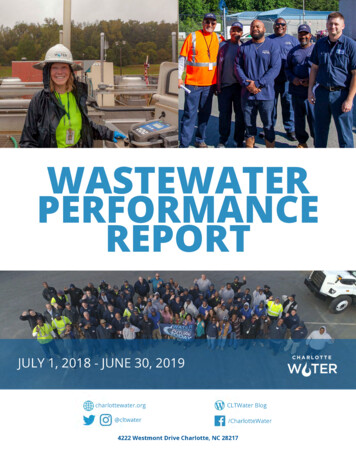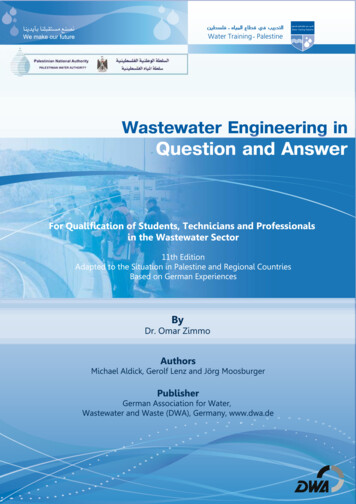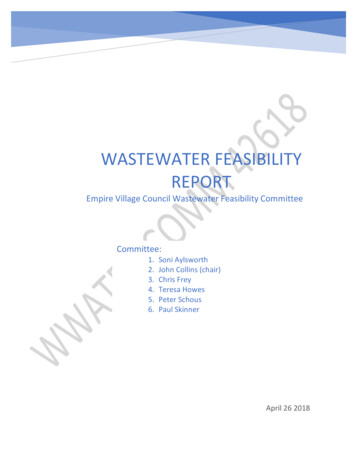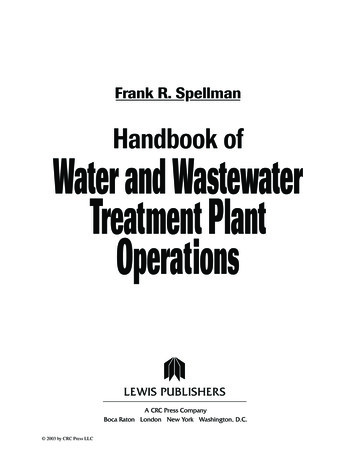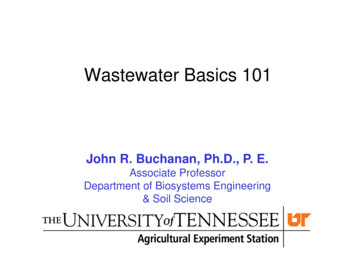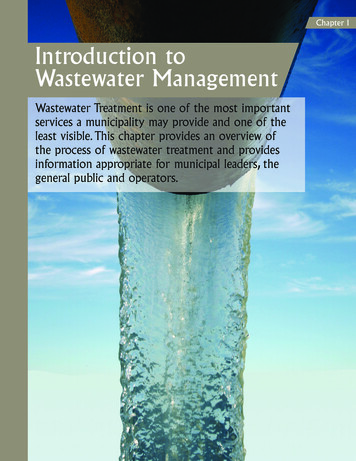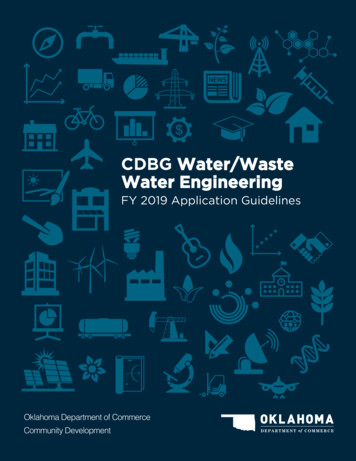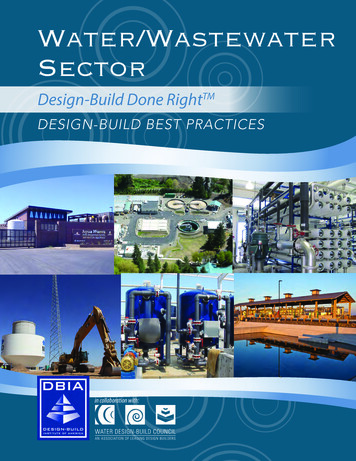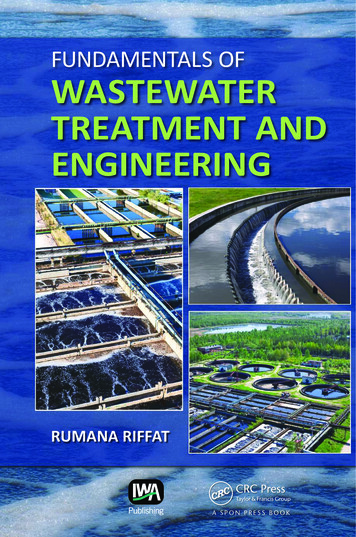
Transcription
FUNDAMENTALS OFWASTEWATERTREATMENT ANDENGINEERINGRUMANA RIFFATA SPON PRESS BOOK
FUNDAMENTALS OFWASTEWATERTREATMENT ANDENGINEERING
FUNDAMENTALS OFWASTEWATERTREATMENT ANDENGINEERINGRUMANA RIFFATA SPON PRESS BOOK
Co-published by IWA PublishingAlliance House, 12 Caxton Street, London SW1H 0QS, UKTel. 44 (0)20 7654 5500, Fax 44 (0)20 7654 BN13 9781780401317CRC PressTaylor & Francis Group6000 Broken Sound Parkway NW, Suite 300Boca Raton, FL 33487-2742 2013 by Taylor & Francis Group, LLCCRC Press is an imprint of Taylor & Francis Group, an Informa businessNo claim to original U.S. Government worksVersion Date: 20120727International Standard Book Number-13: 978-0-203-81571-7 (eBook - PDF)This book contains information obtained from authentic and highly regarded sources. Reasonable efforts have been madeto publish reliable data and information, but the author and publisher cannot assume responsibility for the validity of allmaterials or the consequences of their use. The authors and publishers have attempted to trace the copyright holders of allmaterial reproduced in this publication and apologize to copyright holders if permission to publish in this form has notbeen obtained. If any copyright material has not been acknowledged please write and let us know so we may rectify in anyfuture reprint.Except as permitted under U.S. Copyright Law, no part of this book may be reprinted, reproduced, transmitted, or utilized inany form by any electronic, mechanical, or other means, now known or hereafter invented, including photocopying, microfilming, and recording, or in any information storage or retrieval system, without written permission from the publishers.For permission to photocopy or use material electronically from this work, please access www.copyright.com (http://www.copyright.com/) or contact the Copyright Clearance Center, Inc. (CCC), 222 Rosewood Drive, Danvers, MA 01923, 978-7508400. CCC is a not-for-profit organization that provides licenses and registration for a variety of users. For organizations thathave been granted a photocopy license by the CCC, a separate system of payment has been arranged.Trademark Notice: Product or corporate names may be trademarks or registered trademarks, and are used only for identification and explanation without intent to infringe.Visit the Taylor & Francis Web site athttp://www.taylorandfrancis.comand the CRC Press Web site athttp://www.crcpress.com
This book is dedicated to my husband, Wahid Sajjad,who has been my best friend forever;to my children, Roshan and Mehran,who I hope will use this book someday;and to my parents, Salma and Muhammad Chishty,who have taught me the two most importantthings in life—compassion and humility.v
ContentsPrefaceAcknowledgmentsAbout the authorList of symbolsList of abbreviations1 Sustainable wastewater treatment and uction and history 1Current practice 3Emerging issues 4Future directions 4Regulatory requirements 71.5.1 U.S. regulations 71.5.2 European Union regulations 91.5.3 United Kingdom regulations 10References 112 Reaction kinetics and chemical reactors2.12.22.32.42.52.62.72.813Reaction kinetics 13How to find the order of a reaction 14Zero order reaction 16First order reaction 18Second order reaction 19Reactors 192.6.1 Conversion of a reactant 202.6.2 Detention time in reactor 20Batch reactor 212.7.1 Design equation 21Plug flow reactor (PFR) 232.8.1 Design equation 25vii
viiiContents2.9Continuous-flow stirred tank reactor 262.9.1 Design equation 282.10 Reactors in series 292.11 Semibatch or semiflow reactors 32Problems 32References 343 Wastewater microbiology353.13.2Introduction 35Bacteria 363.2.1 Cell composition and structure 373.2.2 Bacterial growth curve 383.2.3 Classification by carbon and energy requirement 403.2.4 Classification by oxygen requirement 413.2.5 Classification by temperature 413.2.6 Bacteria of significance 413.3 Archaea 433.4 Protozoa 433.5 Algae 453.6 Fungi 463.7 Virus 46Problems 49References 494 Natural purification processes4.14.24.34.44.54.6Impurities in water 51Dilution 51Sedimentation 53Microbial degradation 53Measurement of organic matter 534.5.1 Biochemical oxygen demand (BOD) 544.5.1.1 BOD kinetics 544.5.1.2 Laboratory measurement 584.5.1.3 Unseeded BOD test 584.5.1.4 Seeded BOD test 604.5.1.5 Determination of k and Lo 614.5.1.6 Thomas’s graphical method 614.5.2 Theoretical oxygen demand 62Dissolved oxygen balance 634.6.1 Dissolved oxygen sag curve 6451
Contents4.6.1.14.6.1.2ixCritical points 66Limitations of the oxygensag curve model 70Problems 70References 735 Wastewater treatment fundamentals755.15.25.35.4Introduction 75Sources of wastewater 76Wastewater constituents 76Wastewater treatment methods 785.4.1 Physical treatment 785.4.2 Chemical treatment 785.4.3 Biological treatment 785.5 Levels of wastewater treatment 795.5.1 Preliminary treatment 795.5.2 Primary treatment 795.5.3 Enhanced primary treatment 795.5.4 Conventional secondary treatment 795.5.5 Secondary treatment with nutrient removal 805.5.6 Tertiary treatment 805.5.7 Advanced treatment 805.6 Residuals and biosolids management 805.7 Flow diagrams of treatment options 815.8 Types of biological treatment processes 83Problems 84References 846 Preliminary treatment6.16.26.3Introduction 85Screens 856.2.1 Trash racks 856.2.2 Coarse screens or bar screens 866.2.2.1 Design of coarse screens 876.2.3 Fine screens 906.2.3.1 Design of fine screens 906.2.4 Microscreens 92Shredder/grinder 9285
xContents6.4 Grit chamber 93Problems 97References 987 Primary treatment997.17.27.3Introduction 99Types of settling/sedimentation 99Type I sedimentation 1007.3.1 Theory of discrete particle settling 1007.3.1.1 Stokes equation 1027.3.2 Design of ideal sedimentation tank 1047.4 Type II sedimentation 1077.5 Primary sedimentation 1097.5.1 Rectangular sedimentation tank 1107.5.2 Circular sedimentation tank 1127.6 Chemically enhanced primary treatment 116Problems 116References 1188 Secondary treatment: Suspended growth processes8.18.28.38.4Introduction 119Microbial growth kinetics 1208.2.1 Biomass yield 1208.2.2 Logarithmic growth phase 1228.2.3 Monod model 1228.2.4 Biomass growth and substrate utilization 1238.2.5 Other rate expressions for rsu 1248.2.6 Endogenous metabolism 1248.2.7 Net rate of growth 1258.2.8 Rate of oxygen uptake 1258.2.9 Effect of temperature 126Activated sludge process (for BOD removal) 1268.3.1 Design and operational parameters 1278.3.2 Factors affecting microbial growth 1318.3.3 Stoichiometry of aerobic oxidation 132Modeling suspended growth processes 1328.4.1 CSTR without recycle 1328.4.2 Activated sludge reactor (CSTR with recycle) 1358.4.2.1 Other useful relationships 138119
Contentsxi8.4.3Activated sludge reactor(plug flow reactor with recycle) 1398.4.4 Limitations of the models 1418.4.5 Aeration requirements 1458.4.5.1 Types of aerators 1478.5 Types of suspended growth processes 1508.5.1 Conventional activated sludge 1508.5.2 Step aeration or step feed process 1508.5.3 Tapered aeration process 1508.5.4 Contact stabilization process 1518.5.5 Staged activated sludge process 1528.5.6 Extended aeration process 1528.5.7 Oxidation ditch 1538.5.8 Sequencing batch reactor (SBR) 1538.5.9 Membrane biological reactor (MBR) 1548.6 Stabilization ponds and lagoons 1558.6.1 Process microbiology 1558.6.2 Design of pond or lagoon system 1578.6.3 Design practice 158Problems 161References 1639 Secondary treatment: Attached growth and combinedprocesses9.19.29.39.49.5Introduction 165System microbiology and biofilms 166Important media characteristics 167Loading rates 168Stone media trickling filter 1709.5.1 Design equations for stone media 1719.6 Biotower 1759.6.1 Design equations for plastic media 1759.7 Rotating biological contactor 1799.8 Hybrid processes 1819.8.1 Moving bed biofilm reactor (MBBR) 1819.8.2 Integrated fixed-film activated sludge (IFAS) 1829.8.3 Fluidized bed bioreactor (FBBR) 1839.9 Combined processes 184Problems 184References 187165
xiiContents10 Secondary Clarification18910.1 Introduction 18910.2 Secondary clarifier for attached growth process 18910.3 Secondary clarifier for suspended growth process 19110.3.1 Settling column test 19210.3.2 Solids flux analysis 19410.3.2.1 Theory 19510.3.2.2 Determination of arearequired for thickening 19710.3.3 Secondary clarifier design 199Problems 206References 20711 Anaerobic wastewater treatment11.1 Introduction 20911.2 Process chemistry and microbiology 21111.2.1 Syntrophic relationships 21311.3 Methanogenic bacteria 21411.4 Sulfate-reducing bacteria 21611.5 Environmental requirements and toxicity 21611.6 Methane gas production 21711.6.1 Stoichiometry 21711.6.2 Biochemical methane potential assay 22011.6.3 Anaerobic toxicity assay 22111.7 Anaerobic growth kinetics 22111.8 Anaerobic suspended growth processes 22211.8.1 Anaerobic contact process 22211.8.2 Upflow anaerobic sludge blanket process 22411.8.2.1 Design equations 22511.8.3 Expanded granular sludge bed 22611.8.4 Anaerobic sequencing batch reactor 22811.8.5 Anaerobic migrating blanket reactor 23111.9 Anaerobic attached growth processes 23111.9.1 Anaerobic filter 23111.9.2 Anaerobic expanded bed reactor 23311.10 Hybrid processes 23311.10.1 Anaerobic fluidized bed reactor 23311.10.2 Anaerobic membrane bioreactor 234Problems 235References 236209
Contents12 Solids processing and 9Introduction 239Characteristics of municipal sludge 240Sludge quantification 240Sludge thickening 24612.4.1 Gravity thickener 24612.4.2 Dissolved air flotation 24912.4.3 Centrifugation 251Sludge stabilization 25112.5.1 Alkaline stabilization 25212.5.1.1 Chemical reactions 25212.5.1.2 Lime pretreatment 25312.5.1.3 Lime posttreatment 25312.5.2 Anaerobic digestion 25312.5.2.1 Single-stage mesophilic digestion 25512.5.2.2 Two-stage mesophilic digestion 25912.5.2.3 Thermophilic anaerobic digestion 26612.5.2.4 Temperature-phased anaerobicdigestion (TPAD) 26712.5.2.5 Acid-gas phased digestion 26812.5.2.6 Enhanced enzymic hydrolysisTM 26812.5.2.7 CambiTM process 26912.5.3 Aerobic digestion 27012.5.3.1 Autothermal thermophilicaerobic digestion 27112.5.3.2 Dual digestion 27112.5.4 Composting 273Conditioning of biosolids 274Biosolids dewatering 27512.7.1 Centrifugation 27512.7.1.1 High-solids centrifuge 27512.7.2 Belt-filter press 27612.7.3 Drying beds 276Disposal of biosolids 27712.8.1 Incineration 27712.8.2 Land disposal methods 277Biosolids disposal regulations in the United States 27812.9.1 Class A biosolids 27912.9.1.1 Processes to further reduce pathogens 28012.9.2 Class B biosolids 280
xivContents12.9.2.1 Processes to significantlyreduce pathogens 281Problems 281References 28313 Advanced treatment processes28713.1 Introduction 28713.2 Nitrogen removal 28713.2.1 Biological nitrogen removal 28813.2.1.1 Nitrification–denitrification 28813.2.1.2 Nitritation–denitritation 30113.2.1.3 Deammonification 30213.2.2 Physicochemical process for nitrogen removal 30413.2.2.1 Air stripping 30413.3 Phosphorus removal 30413.3.1 Chemical precipitation 30513.3.2 Biological phosphorus removal 30613.3.2.1 Selected processes for BPR 30713.3.2.2 Phoredox 30713.3.2.3 A 2OTM process 30713.3.2.4 Modified BardenphoTM (five stage) 30713.3.2.5 UCT process 30713.4 Solids removal 30913.4.1 Granular media filtration 30913.4.2 Activated carbon adsorption 31113.4.3 Membrane filtration 31213.4.3.1 Fundamental equations 31313.4.3.2 Membrane fouling 31513.4.3.3 Membrane configurations 31513.4.4 Process flow diagrams 316Problems 316References 318Appendix323
PrefaceThis book is designed for a course on wastewater treatment and engineering for senior level or early graduate level students. As the name suggests,the book covers the fundamental concepts of wastewater treatment followed by engineering design of unit processes for treatment of municipalwastewater. The students should have background knowledge of environmental chemistry and fluid mechanics. One important characteristic of thisbook is that each design concept is explained with the help of an underlyingfundamental theory, followed by a mathematical model or formulation.Problems are presented and solved to demonstrate the use of the mathematical formulations and apply them in design.Chapter 1 starts with a history of wastewater treatment, followed by current practices, emerging concerns, future directions, and pertinent regulations that have shaped the objectives and directions of this important areaof engineering and research. Chapters 2 and 3 describe the fundamentalconcepts of reaction kinetics, reactor design, and wastewater microbiology.Biochemical oxygen demand (BOD) is presented in detail, as it is one ofthe most important measurements for wastewater characteristics. Chapter4 introduces natural purification processes and the dissolved oxygen sagcurve. The concept of simple mass balances is introduced in this chapter.Chapters 5 through 10 describe in detail the unit processes in primary andsecondary treatment. Mass balance is used to develop design equations forbiological treatment processes. A separate chapter, Chapter 11, is providedfor anaerobic treatment, which is becoming more and more important dueto the energy production potential from methane gas generation. Chapter12 describes solids processing and disposal, together with pertinent regulations. A number of problems and their solutions are given to demonstratecalculation of mass and volume of sludge, perform solids balance, and calculate the efficiency. The final chapter, Chapter 13, describes advanced andtertiary treatment processes. Removal of nutrients, such as nitrogen andphosphorus, is presented in detail, followed by processes for solids removal.Recent advances in nitrogen and phosphorus removal are provided. I havexv
xviPrefaceincorporated recent research advances in various sections of the book,wherever applicable.The layout of the book is similar to the manner in which I have taughtthis course at George Washington University (GWU) for the last 18 years.At GWU, I teach this course as Environmental Engineering II, which istaken by senior level students in the Civil and Environmental EngineeringDepartment. The material is covered in one semester consisting of 14weeks. At the end of the course, the student should have an understandingof the fundamental concepts of wastewater treatment and be able to designthe unit processes for treatment of municipal wastewater.
AcknowledgmentsFirst, I would like to express my sincere thanks to my doctoral studentTaqsim Husnain. He has helped with this book in countless ways. Hehas diligently and beautifully prepared all the diagrams and illustrations for this book. I am deeply indebted to him for all his help and forhis assistance in reviewing the manuscript and making corrections. Iwould also like to thank my former doctoral students Sebnem Aynurand Kannitha Krongthamchat for their contributions to Chapters 11and 12.I would like to thank my dear friend Ferhat Zerin for her help in designing the book cover. Finally, I would like to thank my family for all theirpatience and support during this long one year, which made it possible forme to write this book.xvii
About the authorDr. Rumana Riffat is professor of the Civil and Environmental EngineeringDepartment at George Washington University in Washington, D.C. Sheobtained her bachelor’s degree in civil engineering from BangladeshUniversity of Engineering and Technology in Dhaka, Bangladesh, and hergraduate degrees in civil and environmental engineering from Iowa StateUniversity in Ames, Iowa. She has been involved in teaching and researchfor the last 18 years.Dr. Riffat’s research interests are in wastewater treatment, specifically anaerobic treatment of wastewater and biosolids, as well as nutrientremoval. She and her research group have conducted extensive research onprocesses to further reduce pathogens, such as dual digestion, temperaturephased digestion, and various pretreatment options. Her nutrient removalresearch has focused on determination of kinetics and evaluation of variousexternal carbon sources for denitrification. Dr. Riffat is currently involvedin a number of research projects with the District of Columbia Water andSewer Authority at the Blue Plains Advanced Wastewater Treatment Plant,among others.Dr. Riffat received the Distinguished Teacher Award from the School ofEngineering and Applied Science of George Washington University in 2011.She received the George Bradley Gascoigne Wastewater Treatment PlantOperational Improvement Medal of the Water Environment Federation(WEF) in 2010. She is a member of several professional organizations,including WEF and the American Society of Civil Engineers. She is a registered professional engineer of the District of Columbia.xix
List of symbolsαβCCdDdpFFgFbFDΦgKsk1k2kdktLtMoµµ maxµwρpρwPxQRRerdrgrmaxrooxygen transfer correction factorsalinity–surface tension correction factorconcentrationdrag coefficientdissolved oxygen concentrationdiameter of particlefouling factorforce due to gravityforce due to buoyancydrag forceshape factor of particleacceleration due to gravityhalf saturation coefficientBOD rate constantre-aeration rate constantendogenous decay coefficientreaction rate coefficientoxygen equivalent of organic matter remaining at time tmass of oxygenspecific growth rate of biomassmaximum specific growth rate of biomassdynamic viscosity of waterdensity of particledensity of waterbiomass wastedflow raterecycle ratioReynolds numberrate of decaygrowth rate of biomassmaximum biomass production raterate of oxygen uptakexxi
xxiiList of symbolsrsuSSttTθθcVVLvtXYrate of substrate utilizationsubstrate concentrationsubstrate concentration at time ttimetemperaturehydraulic retention timesolids retention timevolume of reactorvolumetric loading rateterminal settling velocitybiomass concentrationbiomass yield coefficient
List of ODBOD5BMPBNRBPRbsCODCEPTCODCSTRCWADAFDDDNADOECE. coliEDCEEHEGSBEPAEUFBBRanaerobic expanded bed reactoranaerobic migrating blanket reactoractual oxygen transfer rateacid phase digestionactivated sludgeanaerobic sequencing batch reactoranaerobic toxicity assayautothermal thermophilic aerobic digestionadvanced wastewater treatment plantbiodegradable chemical oxygen demandbiochemical oxygen demand5 d biochemical oxygen demandbiochemical methane potentialbiological nutrient removalbiological phosphorus removalbiodegradable soluble CODchemically enhanced primary treatmentchemical oxygen demandcontinuous-flow stirred tank reactorClean Water Actdissolved air flotationdual digestiondeoxyribonucleic aciddissolved oxygenEuropean CommissionEscherichia coliendocrine disrupting compoundenhanced enzymic hydrolysisexpanded granular sludge bedEnvironmental Protection AgencyEuropean Unionfluidized bed bio-reactorxxiii
xxivList of SORSOTRfecal coliformFederal Water Pollution Control Actgranular activated carbonhydraulic retention timeintegrated fixed-film activated sludgemesophilic anaerobic digestionmoving bed biofilm reactormembrane biological reactormicrofiltrationmillion gallons per daymodified Lutzack–Ettingermixed liquor suspended solidsmixed liquor volatile suspended solidsmost probable numbernitrogenammoniananofiltrationNational Pollutant Discharge Elimination Systemnitrogenous oxygen demandorganic loading rateoxygen utilization ratepowdered activated carbonphosphorus-accumulating organismspolyethersulfoneplug flow reactorprocesses to further reduce pathogenspoly-hydroxy-butyratepublicly owned treatment workspolysulfoneprocesses to significantly reduce pathogenspolyvinyl chloridepolyvinylidene difluoridereturn activated sludgerotating biological contactorribonucleic acidreverse osmosissequencing batch reactorsoluble chemical oxygen demandspecific denitrification ratesand equivalent sizesingle reactor system for high ammonium removal over nitritesynthetic organic compoundsurface overflow ratesoxygen transfer rate at standard temperature and pressure
List of UFUKUVVFAVSVSSWASsolids retention timestandard temperature and pressuretotal coliformtrickling filtertheoretical oxygen demandtotal Kjeldahl nitrogentotal maximum daily loadtotal organic carbontemperature-phased anaerobic digestiontotal solidstotal suspended solidsupflow anaerobic sludge blanketultrafiltrationUnited Kingdomultravioletvolatile fatty acidvolatile solidsvolatile suspended solidswaste-activated sludgexxv
Chapter 1Sustainable wastewatertreatment and engineering1.1 INTRODUCTION AND HISTORYThe science and engineering of wastewater treatment has evolved significantly over the last century. As the population of the world has increased,our sources of clean water have decreased. This has shifted our focustoward pollution reduction and control. Disposal of wastes and wastewaterwithout treatment in lands and water bodies is no longer an option. Anincreasing body of scientific knowledge relating waterborne microorganisms and constituents to the health of the population and the environmenthas spurred the development of new engineered technologies for treatmentof wastewater and potential reuse.The term wastewater includes liquid wastes and wastes transported inwater from households, commercial establishments, and industries, as wellas stormwater and other surface runoff. Wastewater may contain high concentrations of organic and inorganic pollutants, pathogenic microorganisms, as well as toxic chemicals. If the wastewater is discharged withouttreatment to a stream or river, it will result in severe pollution of the aquaticenvironment. The decline in water quality will render the stream waterunusable for future drinking water purposes. Sustainable wastewater engineering involves application of the principles of science and engineeringfor the treatment of wastewater to remove pollutants or reduce them to anacceptable level prior to discharge to a water body or other environment,without compromising the self-purification capacity of that environment.The treatment and disposal of the generated solids and other by-products isan integral part of the total process.If we look back in time, wastewater engineering has progressed fromcollection and open dumping, to collection and disposal without treatment,to collection and treatment before disposal, all the way to collection andtreatment prior to reuse. Evidence of waste collection in the streets and thenuse of water to wash the waste through open sewers has been found in theancient Roman empire. In the early 1800s, the construction of sewers wasstarted in London. In 1843, the first sewer system, in Hamburg, Germany,1
2Fundamentals of wastewater treatment and engineering was officially designed by a British engineer, Lindley (Anon, 2011). In seventeenth century Colonial America, household wastewater managementconsisted of a privy (toilet) with an outlet constructed at ground level thatdischarged outside to a cesspool or a sewer. With low population densities,privies and cesspools constructed in this way did not cause many problems(Duffy, 1968). But as the population increased, the need for an engineeredsystem for wastewater management in large cities became more evident.Scientists and public health officials started to understand the relationship between disease outbreaks and contamination of drinking water fromwastewater. Nuisance caused by odors, outbreak of diseases, e.g. cholera,and other public health concerns prompted the design of a comprehensivesewer system in Chicago in the 1850s. At that time, the sewer system wasused to transport the untreated wastewater outside of the residential community to a stream or river. Dilution of the wastewater with the streamwater was the primary means of pollutant reduction. These were calledwater-carriage sewer systems.Public health concern in the 1850s also resulted in the planning and development of a water-carriage sewer system for the city of London. A cholera epidemic struck London in 1848 and again in 1854, causing more than25,000 deaths (Burian et al., 2000). Dr. John Snow was the first doctorat that time to establish a connection between the cholera outbreak and acontaminated water supply at the Broad Street public well. In addition, heshowed statistically that cholera victims had drawn their drinking water froma sewage-contaminated part of the river Thames, while those who remainedhealthy drew water from an uncontaminated part of the river. These findings, together with the discoveries by Pasteur and Koch, prompted the BritishParliament to pass an act in 1855 to improve London’s waste managementsystem. This led to the development of a comprehensive water-carriage sewersystem for London, designed by Joseph Bazalgette (Hey and Waggy, 1979).Toward the beginning of the twentieth century, sewage treatment plantsmainly used settling tanks (primary treatment) to remove suspended particles from the wastewater before discharge to streams and rivers. In theearly 1900s, about one million people in the United States were served by60 such treatment plants. In the early 1900s, the first trickling filter wasconstructed in Madison, Wisconsin, to provide biological (secondary) treatment to wastewater. The Imhoff tank was developed by German engineerKarl Imhoff in 1906 for solids separation and further treatment. The firstactivated sludge process was constructed in San Marcos, Texas, in 1916(Burian et al., 2000). Advances in sludge digestion and gas production werealso being accomplished by researchers and utilities. From the mid-1900sto the present time, we have seen development of various types of biological and biochemical processes for the removal of pollutants from wastewater. The earlier objectives were mainly to reduce the total suspendedsolids (TSS), biochemical oxygen demand (BOD), and pathogens. Primary
Sustainable wastewater treatment and engineering3and secondary biological treatment was considered sufficient for production of treated wastewater of acceptable standards. With industrializationand scientific advances, chemical and toxic compounds have been detectedin municipal wastewater treatment plant influents. This has resulted in theneed for additional treatment beyond the secondary, giving rise to tertiarytreatment. Tertiary or advanced treatment can be physical, chemical, orbiological, or a combination of these processes.1.2 CURRENT PRACTICEPrimary treatment in most municipal wastewater treatment plants consists ofpreliminary and primary stages. It typically includes screens, grit chambers,comminutors, and primary clarifiers, depending on the flow rates. Largerplants use chemically enhanced primary clarification for higher solids-removalefficiency. Primary treatment is followed by secondary treatment. Secondarytreatment consists of a biological process followed by a secondary clarifier.If the secondary effluent meets the regulatory standards for BOD and TSS,then it is discharged to receiving waters following disinfection. The solids andsludge collected from the various units undergo further processing and treatment before disposal. Various options are available for sludge processing. Aconventional wastewater treatment plant is illustrated in Figure 1.1.More than half of the municipal wastewater treatment plants in theUnited States are capable of providing at least secondary treatment. About92% of the total flow is treated by plants with a capacity of 0.044 m3/s(1 million gallons per day or Mgal/d) or larger (Metcalf and Eddy, 2003).In the last two decades, nutrient removal has become increasingly morePreliminary and Primary s tolandfillGritChamberGrit tolandfillSecondary yclarifierDisinfectantEffluentSludge rWastewater flowSludge flowEffluent recycledthru secondaryreactorAnaerobicdigesterCentrifugeSludge treatmentFigure 1.1 Flow diagram of a conventional wastewater treatment plant.Biosolidsfor landapplication
4Fundamentals of wastewater treatment and engineering important in parts of the United States, as well as in Europe and Asia.Eutrophication caused by excessive nitrogen and phosphorus in wastewater discharges has disrupted the aquatic life in receiving water bodies,with a subsequent decline in water quality. Wastewater treatment plants inaffected areas and watersheds have to provide additional nutrient removalprior to discharge. Biological nutrient removal is incorporated as part ofthe secondary treatment or as tertiary treatment. Nutrient removal is nolonger considered an advanced treatment option. An example of this is theChesapeake Bay watershed in the eastern United States and the municipalwastewater treatment plants within the watershed. Most of the plants usebiological nitrification–denitrification together with BOD removal, and/orchemical precipitation for removal of phosphorus. Use of granular mediafiltration as tertiary treatment for reduction of total suspended solids isalso quite common. Table 1.1 presents the pollutants commonly found inmunicipal wastewater and the physical, chemical, and biological processesused to remove or reduce their concentrations.1.3 EMERGING ISSUESThe following are areas of importance and concern for municipal wastewater treatment plants: Rising energy costs for operation of treatment plantsDisposal of biosolids in a sustainable mannerPerformance and reliability of plants in the digital agePresence of endocrine disrupting compounds (EDC) in wastewaterPresence of toxic chemicals in wastewater from household products
Environmental Engineering As the world’s population has increased, sources of clean water have decreased, shifting the focus toward pollution reduction and control. Disposal of wastes and wastewater wi
